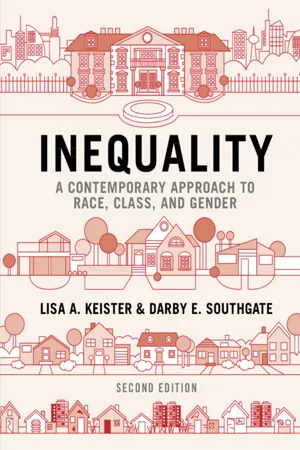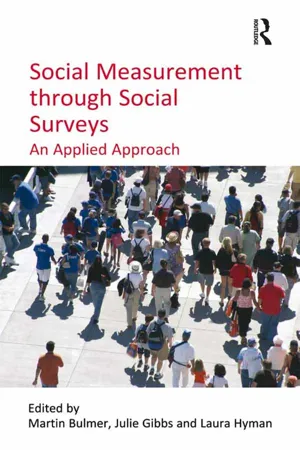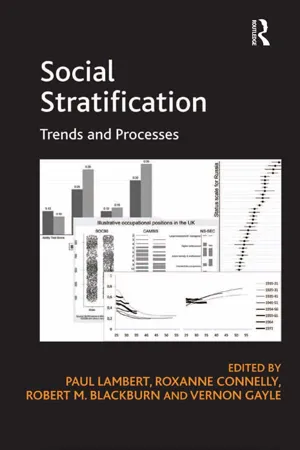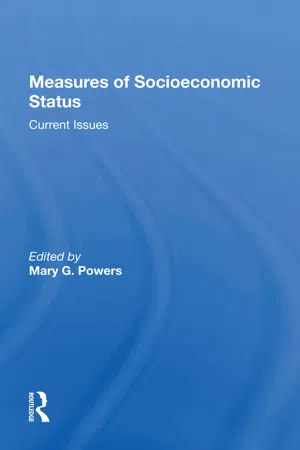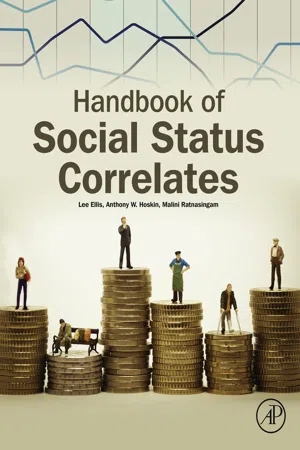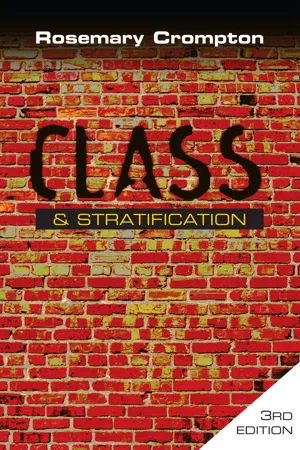Social Sciences
Defining and Measuring Social Class
"Defining and Measuring Social Class" involves categorizing individuals or groups based on their economic, social, and cultural characteristics. This can be done using various indicators such as income, education, occupation, and lifestyle. The measurement of social class helps researchers and policymakers understand social inequalities and their impact on society.
Written by Perlego with AI-assistance
Related key terms
1 of 5
9 Key excerpts on "Defining and Measuring Social Class"
- eBook - PDF
- Sarah Boslaugh, Sarah E. Boslaugh(Authors)
- 2007(Publication Date)
- SAGE Publications, Inc(Publisher)
Social sciences, as well as social epidemiology, consistently recognize that behind any socioeconomic classification there is a multidimensional construct comprising diverse social and economic factors. It is increasingly acknowledged that a fundamental distinc-tion between ‘‘social class,’’ ‘‘social status,’’ and mea-sures of material living standards is needed to clarify definitions, measures, and interpretations associated with a given socioeconomic classification. This would include distinguishing between income , assets , and wealth (i.e., those based on individual and household ownership of goods), terms frequently used loosely and interchangeably despite their different theoretical foundations. Social classes— hierarchical distinctions between individuals or groups in societies or cultures—are social groups arising from interdependent economic relationships among people. These relationships are governed by the social structure as expressed in the customs, values, and expectations concerning property distribution, ownership, and labor and their connec-tions to production, distribution, and consumption of goods, services, and information. Hence, social clas-ses are essentially shaped by the relationships and conditions of employment of people in the society and not by the characteristics of individuals. These class relationships are not symmetrical but include the ability of those with access to resources such as capi-tal to economically exploit those who do not have access to those resources. Unlike social class, social status involves the idea of a hierarchy or ranking based on the prestige, honor, and reputation accorded to persons in a society. Socie-tal sources for attribution of status, that is, a relative position in the social ladder, are diverse but chiefly concern access to power, knowledge, and economic resources. Both social class and social status can be regarded as representations of social position. - eBook - ePub
Social Class and Classism in the Helping Professions
Research, Theory, and Practice
- William M. Liu(Author)
- 2010(Publication Date)
- SAGE Publications, Inc(Publisher)
The converse to these bobos are those I would regard as the “passers.” These are individuals who may come from humble and poor backgrounds but aspire to be wealthy and affluent. These individuals want to be perceived by others as part of a particular social class, so they take on the behaviors and attitudes that mimic those in higher social classes. These folks may be dishonest about their backgrounds or be vague and opaque. It may be extremely difficult for the helping professional to have these individuals reveal their true social class background. These individuals may also be in a recurring debt cycle—probably a lifestyle largely leveraged on credit cards and other loans or extended mortgages—so that they may pursue or express a particular lifestyle or material excesses that are valued by the higher-social-class group to which they aspire. For these individuals, current ways of understanding their social class experiences and perceptions do not capture the complexity of how they conceptualize themselves as part of a social class group.Implications for Practice
Throughout this chapter I have attempted to identify the shortcomings of current theories, paradigms, and frameworks on measuring social class and classism. Here, I will distill what I have presented into some practical considerations for helping professionals.1. Helping professionals should identify specific variables of social class and define them in ways that may be observed and measured. Operationalizing these variables and even connecting these variables to a larger coherent theory of social class is important in research.2. Try to provide some context to the data about to be collected. If income or some other discrete variable is of interest, provide a reference point by which a comparison may be made. For instance, examine demographic or census tract data about income for the specific population or community being measured and present these data.3. Look for measures or portions of measures that may be used or adapted to assess for social class or classism. Rather than looking only for social class measures, helping professionals may look broadly at other ways social class is conceptualized such as social status, mobility, self-perception, acculturation, identity, or worldview. These measures should reflect some psychological, interpersonal, or intrapsychic experience and not a measure of classification or categorization.4. Always give some consideration to the role of classism in social class. Helping professionals should consider social class and classism to be interdependent constructs that provide meaning and information to each other much like race and racism or gender and sexism, to name a few. Self-perceptions and attitudes of social class are often shaped by socialization and experiences with discrimination (i.e., classism), so there is a compelling interest to consider both. - eBook - PDF
Inequality
A Contemporary Approach to Race, Class, and Gender
- Lisa A. Keister, Darby E. Southgate(Authors)
- 2022(Publication Date)
- Cambridge University Press(Publisher)
Naturally, the relevance of class identity varies across people, over time, and from place to place. We discuss this in more detail later in the chapter, but for now it is useful to be aware that class can be an important part of a person’s identity. This suggests that people have a conception of class groups and, therefore, that the groups are real. To fully understand the definition and measurement of class and why debates arise regarding its meaning and implica- tions, it is helpful to consider two dimensions: economic and cultural. We address those dimensions before considering how many classes there are, class consciousness, and implications of social class. 100 4 The Structure of Inequality and Social Class American Class Structure: Economic Dimensions A common way to identify class position is to use economic traits. From this perspective, social class is seen as a group of people with relatively common wealth, income, occupation, and education. Social classes typically are relatively large groups of people who are similar to one another on these measures and distinct from others. Using economic characteristics to identify class is a relatively objective method of categorizing people. Sociologists often refer collectively to these traits as socioeconomic status (SES). The process of grouping people based on these traits can be complicated because the measures are interrelated but not perfectly correlated, which leads to difficulty when deciding where one group ends and the other begins. For example, people with high incomes usually have high wealth because greater income makes it easier to save money. Figure 4.1 uses income, wealth, and occupational prestige to array the U.S. population in a way that might be useful for identifying class boundaries. Disagreements arise when identifying social classes because the relationships among these variables are not perfect. - eBook - ePub
Social Measurement through Social Surveys
An Applied Approach
- Julie Gibbs, Martin Bulmer(Authors)
- 2016(Publication Date)
- Routledge(Publisher)
Chapter 6Measuring Social ClassEric Harrison*Introduction
This chapter deals with the issues raised when social scientists wish to make use of survey instruments to measure social class and explore its effects. It is organized in the following way. It starts by explaining the continuing salience of class as a sociological variable, and its importance as a core component of large-scale social surveys. The following section explains the need for conceptually grounded models of class, and discusses one such model (EGP) based on the theory of employment relations. Part three discusses the data requirements for its full operationalization via a combination of information on occupation, employment status and supervisory responsibility. The next part goes on to explore the limitations of real-world survey data and some pragmatic steps that can be taken to deal with incomplete and imperfect information from questionnaires. Part five explores the concept of ‘validation’ in relation to measures of class, and the extent to which this is achieved in practice. The final section evaluates the current relationship between class analysis and survey research and makes suggestions for future improvements.The Continuing Significance of Class
Class holds a unique position in the canon of sociological concepts. It is arguably the discipline’s most hotly contested concept, and yet it also remains its most powerful. As has often, rather wistfully, been remarked, class is ‘sociology’s only independent variable’. If this really is a paradox, then it has always been so. Indeed, ‘talk of class being in decline is not novel, it is one of the constants’ (Roberts, 2001: 11). Most, if not all, of this kind of debate stems from a lack of clarity about what class actually is - eBook - ePub
Social Stratification
Trends and Processes
- Roxanne Connelly, Vernon Gayle, Paul Lambert(Authors)
- 2016(Publication Date)
- Routledge(Publisher)
Chapter 2Stratification Research and Occupation-Based Social Classifications
Paul Lambert and Erik Bihagen1. Introduction
This chapter reviews practice – and malpractice – in using occupational data as a means to indicate social stratification position. After describing standard approaches and well-known problems, we claim that measures are often operationalised in a sub-optimal way: many researchers do not take advantage of suitable or plausible measurement instruments (see section 2), and many researchers make unsubstantiated theoretical interpretations from patterns based upon occupational data (see section 3). On the contrary, we argue that researchers should make more use of sensitivity analysis comparing different schemes, and we highlight resources and methodological strategies for comparison that can help in this regard.Our focus is on instances where detailed occupational data stored on survey datasets is used to generate measures of position within the structure of social stratification. In such approaches, the initial data may cover occupational descriptions (job titles) alone, or be supplemented with data on employment status. Operationalising an occupation-based social classification conventionally involves grouping or scaling the detailed occupational categories into more parsimonious measures of stratification position. Many different occupation-based scales and categorisations have been recommended. This chapter seeks to provide a sketch of current possibilities, and recommendations of good practice, in using occupational data (section 2); discussion of ongoing problems in this process (section 3); and some empirical results on the qualities of alternative occupation-based measures (section 4).2. Operationalising occupation-based social classifications
Why study occupations and occupation-based measures?
Detailed occupational data is collected in social survey research for three very good reasons. First, it has long been recognised that people’s occupations are central to their position within the social structure (esp. Parkin 1972). Occupations are regarded as very good markers of social experience – for instance in terms of income, lifetime income and living standards (e.g. Watson et al . 2010, Goldthorpe and McKnight 2006, Weeden 2002), and lifestyle and cultural preferences (e.g. Chan 2010). By extension, occupations make very natural indicators of individuals’ positions within social structures of inequality, and indeed for many, the structure of social inequalities is both indicated by occupations, and can itself be seen as forged in and maintained by social relations defined by occupations (e.g. Rose and Harrison 2010, chapter 1 , Jonsson et al - eBook - ePub
Measures Of Socioeconomic Status
Current Issues
- Mary G Powers(Author)
- 2021(Publication Date)
- Routledge(Publisher)
2.
Measurement of Socioeconomic Status from United States Census Data
Charles B. Nam, E. Walter TerrieDOI: 10.4324/9780429049170-2Introduction
The origin of the term “socioeconomic status” (SES) is difficult to determine, but social scientists have long used the phrase to denote the relative location of an individual or group within a socially desirable hierarchy. Max Weber identified three distinct but interrelated aspects of the social hierarchy--namely, class, status, and party (Gerth and Mills, 1958). He regarded “party” as the power to influence one’s own affairs and that of others, “status” as the regard with which individuals are held by others, and “class” as the social and economic life chances which people experienced. It is in this latter sense that researchers have looked for measures of socioeconomic status as a basis for indicating social class, and it is this common understanding of the term that led to the definition of “socioeconomic” in Webster’s Third New International Dictionary (1976) as “of, relating to, or involving a combination of social and economic factors; specifically, of or relating to income and social position considered as a single factor.”The inability of social researchers to develop consensus on the real distinctions between class, status, and party, and further difficulty in specifying the nature of the interrelationships and the variables which are determinants of each aspect, has placed measurement of socioeconomic status in an uncertain position. The numbers and types of indexes and scales of SES are considerable and, while most of them are highly intercorrelated empirically, they each offer variations in concept and in procedures for their calculation. - eBook - ePub
- Lee Ellis, Anthony W. Hoskin, Malini Ratnasingam(Authors)
- 2018(Publication Date)
- Academic Press(Publisher)
Chapter 1Conceptualizing and Measuring Social Status
Abstract
This chapter provides a summary of how social status (or socioeconomic status, SES) is conceptualized and measured. Special emphasis is placed on the three most common SES measures: years of education, occupational level (or prestige), and income or wealth. Other SES measures, such as subjective social status, are also discussed. Findings cited have to do with how each of the various measures of social status correlate with one another regarding both adult social status and the status of their dependent offspring.Keywords
Adults; Conceptualization; Dependent offspring; Income; Interrelationships between SES measures; Measurement; Neighborhood status; Occupational level; Social status; Socioeconomic status; Subjective social status; Wealth; Years of educationChapter Outline1.1 Forms of Social Stratification 1.2 Basic Terminology: Social Status Versus Social Class 1.3 The Tripartite Social Status Measures 1.3.1 Parental Versus Own Social Status 1.3.2 Neighborhood Social Status 1.3.3 Special Issues Surrounding Each of the Tripartite Measures 1.3.3a Special Issues Involving Education Measures 1.3.3b Special Issues Involving Occupational Level Measures 1.3.3c Special Issues Involving Income and Wealth Measures 1.4 Nontripartite Socioeconomic Status Measures 1.4.1 Leadership and Eminence 1.4.2 Social Mobility 1.4.3 Self-Rated Social Class 1.4.4 Subjective Social Status 1.4.5 Ownership Socioeconomic Status Measures 1.4.6 Income-To-Need Measures 1.4.7 Additional Measures of Social Status 1.4.8 Multiple Socioeconomic Status Indexes 1.5 Overall Assessment of Social Status Measurement 1.6 Intercorrelations Between Indicators of Social Status 1.6.1 Years of Education and Occupational Level - eBook - ePub
- Rosemary Crompton(Author)
- 2015(Publication Date)
- Polity(Publisher)
The economic, technical and social changes brought about by the continuing development of capitalist production, distribution and exchange have been accompanied by a continuing division of labour and differentiation of occupations. The point need not be laboured that ‘occupation’ has become, for the majority of the population, probably the most powerful single indicator of levels of material reward, social standing, and ‘life chances’ in general in modern societies (Blau and Duncan 1967: 6–7). Thus throughout the twentieth century and into the twenty-first, it has become commonplace for social researchers of all kinds (in academia, government and commercial agencies, and so on) to divide up the occupational structure into aggregates corresponding to different levels of social and material inequalities, which are commonly known as ‘social classes’. Reid (1981: 6), for example, defines a ‘social class [as] a grouping of people into categories on the basis of occupation’, and Parkin has asserted that: ‘The backbone of the class structure, and indeed of the entire reward system of modern Western society, is the occupational order’ (1972: 18).However, despite its acknowledged usefulness as a social indicator, there are a number of difficulties in using occupation as a measure of ‘class’ (Reid 1998: 11–13). Four major areas of difficulty may be identified. First, there is the fact that only a minority of members of contemporary societies will be ‘economically active’, and therefore have or be seeking an occupation, at any time. A variety of strategies are available for allocating the ‘economically inactive’ (children, old people), or those without an occupation, to an occupational class. These include giving all household members the same ‘class’ as that of the ‘head of household’ or ‘main breadwinner’, and locating the retired in the ‘class’ indicated by their last occupation. It has been argued that this strategy has been a reasonably successful one (Marshall et al. 1996). However, the minority of the long-term unemployed, including people who have never had a job at all, present a continuing problem for employment-based class schemes. - eBook - ePub
Class
Key Concept in Sociology
- Stephen Edgell(Author)
- 2008(Publication Date)
- Routledge(Publisher)
3 The measurement of classINTRODUCTION
The process by which the classical and contemporary approaches to the meaning of class discussed in the first two chapters are transformed from a theoretical idea into a measurable form is called operationalization. On the assumption that it is both desirable and possible to develop a ‘scientific sociology’, the process of operationalizing concepts is crucial to the achievement of reliable (i.e. the extent to which repeated measurements produce the same results under the same conditions) and valid (i.e. the extent to which a measure is an accurate representation of the phenomenon the researcher wishes to investigate) empirical data. Thus, operational definitions impart clarity and precision to sociological analysis and are therefore at the core of empirical sociology (cf. Pawson 1989). Since class is simultaneously one of the most important and widely used and abused concepts in sociology, in addition to being one of the most controversial, it is imperative to be clear from the outset not only what one means by the term, but also how one intends to measure it. Until recently, this aspect of class analysis had received little attention in contrast to the plethora of theoretical and substantive contributions. The change in emphasis has been stimulated by the reorientation of neo-Marxism away from abstract theorizing and toward empirical analysis (e.g. Wright 1979), and by the emergence of a feminist critique of ‘malestream’ sociology (Abbott and Wallace 1990).
Index pages curate the most relevant extracts from our library of academic textbooks. They’ve been created using an in-house natural language model (NLM), each adding context and meaning to key research topics.


